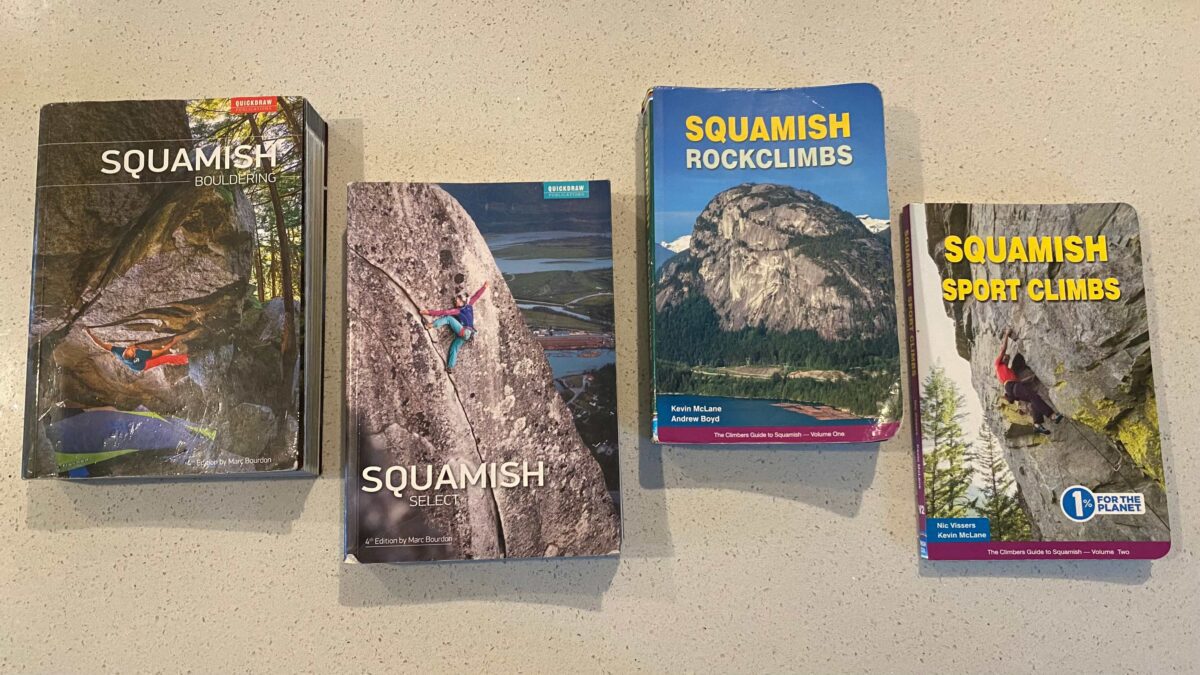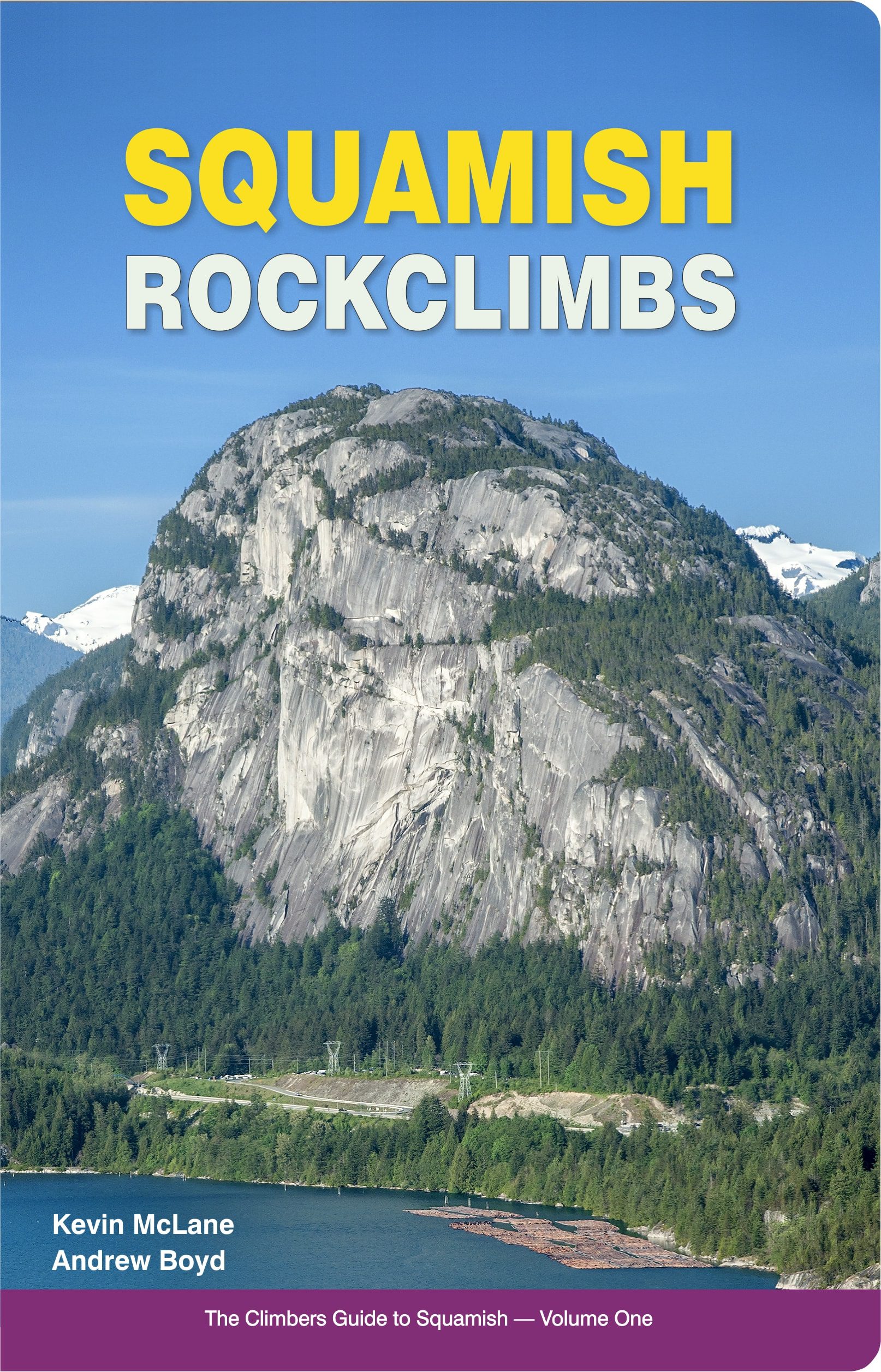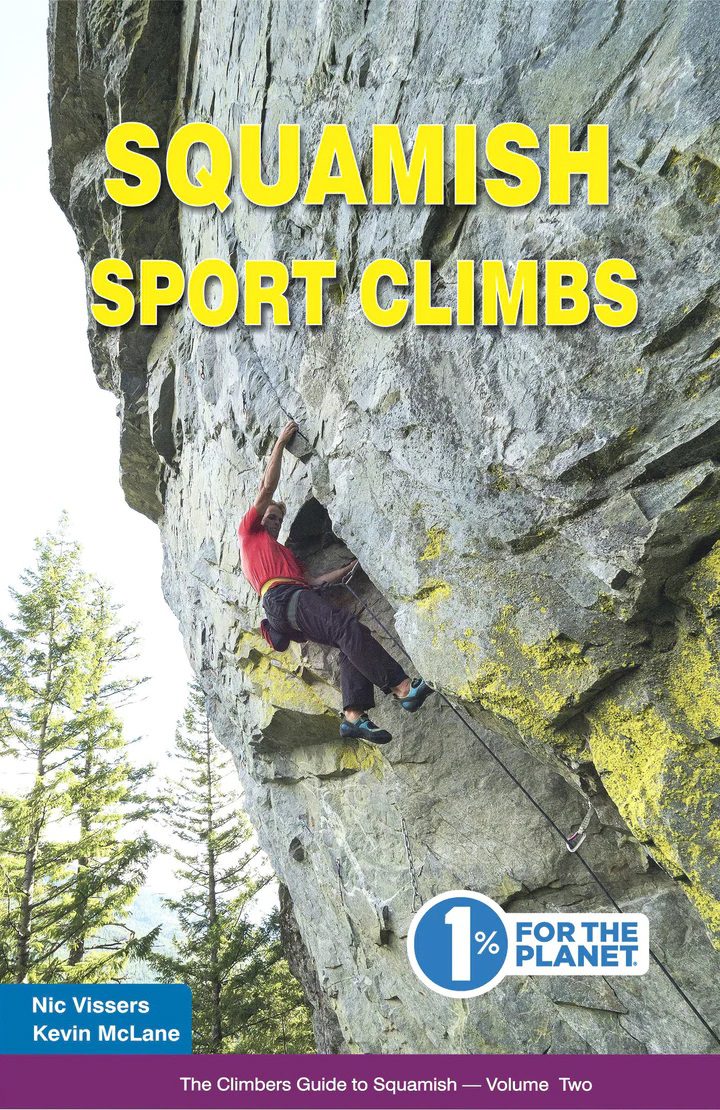Visiting Squamish in 2024? Here’s Which Guidebook You Should Get
A breakdown of the five Squamish climbing guidebooks currently available for purchase

Are you taking a trip to Squamish soon and currently shopping for a guidebook? Here’s a quick overview on the strengths and weaknesses of the four books and one app currently available for purchase. Whether you’re bouldering, sport climbing, trad climbing, or multi-pitching, there’s a high-quality Squamish guidebook for you that’ll help you make the most of your trip.
Squamish Bouldering by Marc Bourdon (2022)
If you’re coming to Squamish for bouldering and want a physical guidebook, your choice is simple: pick up a copy of Squamish Bouldering by Marc Bourdon. The guidebook is the go-to print resource for bouldering in and around Squamish. Now in its 4th edition, this classic guidebook was extensively updated and re-released in 2022.
If you have an old 3rd edition version, it’s definitely worth upgrading to the new 4th edition, as it includes a ton of new problems, particularly in the North Walls. For sale in both physical and digital forms, the guide covers 3,590 problems – a mind-blowing number.
KAYA Digital Squamish Bouldering Guidebook
In June 2023, KAYA released a digital Squamish bouldering guidebook. Written by Squamish’s original bouldering guidebook author, Peter Michaux, and long-term Squamish developer and KAYA co-founder, Marc Bourguignon, the guide covers nearly 4,000 boulder problems in and around Squamish.
In the new KAYA guide, every Squamish boulder is GPS-tagged and every trail to reach the boulders is meticulously mapped in GPS as well. Similar to Google Maps, you follow your little blue dot along the trails in the KAYA map to arrive at your desired destination. Each boulder has its own icon that you can tap to look at its topo, read problem descriptions, view community ascent history, and watch user-uploaded beta videos. You can record your sends in the app and look at summary statistics of your climbs over time.
The free version of KAYA will get you access to many of the app’s features but a Pro subscription (paid monthly or annually) is highly recommended. With Pro, you get access all guidebooks on the platform – including Squamish. These guidebooks include detailed climb descriptions, topos, and verified GPS data of the boulders, trails, and parking. You also have the ability to store all this information in offline mode for use in areas with poor data connection. The KAYA Squamish guide contains a few areas not included in Squamish Bouldering, including the popular Portal area near Porteau Cove.
For anyone who boulders in Squamish and plans on travelling to one of KAYA’s many other digital guidebook destinations in the U.S. or Canada, getting a Pro subscription is a no-brainer. I personally love my combo of Squamish Bouldering and the KAYA app. Researching and finding boulders in Squamish has never been so easy.
If you’re coming to Squamish for roped climbing, you have a few guidebook options. There are three books currently for sale covering roped climbing in Squamish: Squamish Select, Squamish Rockclimbs, and Squamish Sport Climbing.
Squamish Select by Marc Bourdon (2020)
You’d be hard-pressed to find a more user-friendly book anywhere in the world than Squamish Select. Now on its 4th edition, this 2020 book is Squamish’s most recent roped climbing guide. While the book is technically a “select” and doesn’t cover every previously established route in town, it easily covers the needs of the vast majority of climbers.
Murrin Park, the Smoke Bluffs, and all of Squamish’s sport crags (as of 2020) have full comprehensive coverage in the book. The multi-pitching walls in and around the Chief are still extensively covered – the classics are all there – but the book does omit some of the more obscure lines and crags.
I’d recommend Squamish Select to essentially every climber looking to climb routes in Squamish. The area maps, parking and approach instructions, crag topos, and route descriptions are of the highest quality. The guide is sold as both a physical book and a digital PDF. If you already own the old 3rd edition from 2012, you really should upgrade as the 4th edition covers lots of new route development.
Squamish Rockclimbs by Kevin McLane and Andrew Boyd (2018)
Squamish Rockclimbs is the first installment of a two-part series by High Col Press. The book covers Squamish climbing from Murrin Park in the south to the Smoke Bluffs and Crumpit Woods in the north. Squamish’s major northern sport climbing areas (Paradise Valley, Area 44/Pillary, Chek, Rogues’ Gallery) are not covered in the guide.
The book is the only one currently available that has extensive coverage of Mount Habrich and Sky Pilot areas, including crags around the Sea-to-Sky Gondola and the epic Fluffy Kitten wall. It also includes stunning sea cliff climbing near town. You’ll find more lines, link-ups, and variations in and around the Stawamaus Chief than you will in other guidebooks.
The topo photos throughout the book are extremely high-resolution, making it easy to decipher your line. Route descriptions tend to be brief or non-existent, a style that some climbers may enjoy. In the middle of the guide, you get a fascinating section nearly 100 pages in length of old photos, classic stories, and the history of climbing in Squamish. This book should not be missed by those living nearby, visiting often, or staying for an extended trip.
Squamish Sport Climbs by Nic Vissers and Kevin McLane (2019)
Squamish Sport Climbs is the second volume to Squamish Rockclimbs described above. As the title suggests, the book covers sport climbing in and around Squamish, from Murrin Park in the south all the way to Whistler in the north. Because Squamish Rockclimbs features extensive coverage of Murrin Park, the Chief, and the Smoke Bluffs, this volume doesn’t fully describe the sport climbs in these areas, which means you need both books for a comprehensive guide of Squamish sport climbing.
This sport climbing guide contains information on a few crags not covered in any other guidebook currently for sale. These include walls in “The Gorge” near the famous Star Chek 5.9, Starvation Crag (a peaceful wall of trad and mixed lines on the Sea to Sky Trail), and a bunch of crags in nearby Whistler. This book is the lightest and least expensive of the ones included in this list. Like its first volume, the route descriptions in Squamish Sport Climbs tend to be brief or non-existent, but the topos are very high quality and easy to follow.
If you are on a tight budget, want a thin, light guidebook, and plan to climb primarily at sport crags north of Squamish, then Squamish Sport Climbs is a good option for you.







